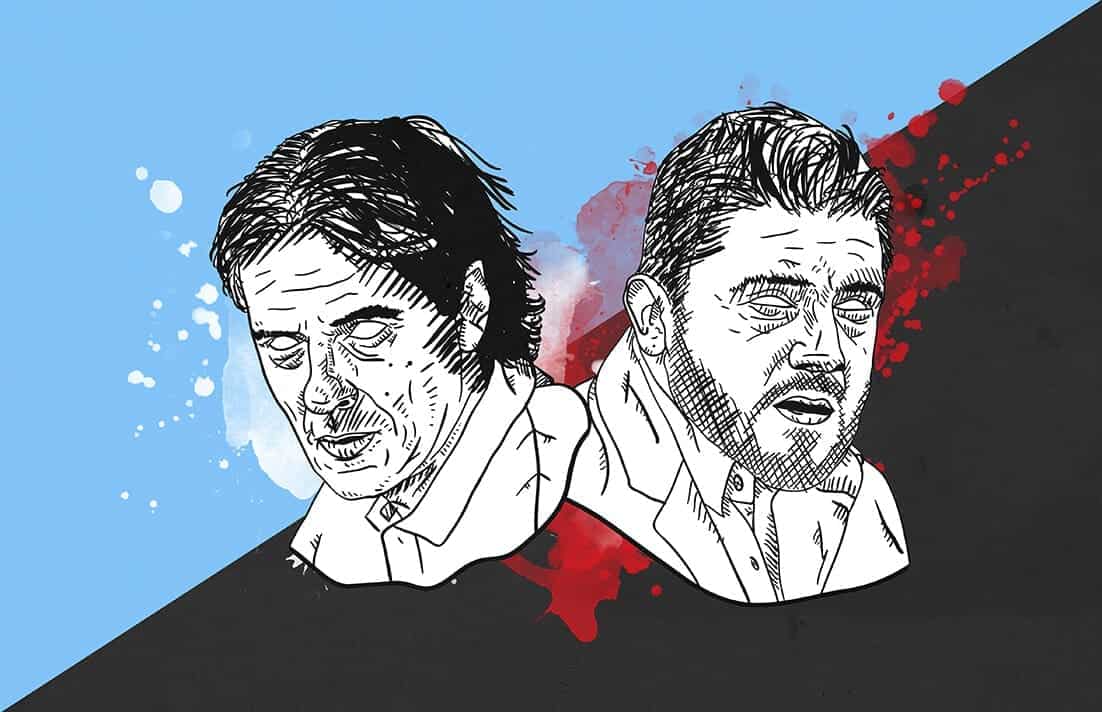As injuries have been getting the best of Milan, Gattuso was forced to reshuffle his cards and field an unprecedented eleven. Often criticised for his overly defensive approach, the former destroyer had his side 5th in Serie A, 1 point off Lazio, making the game between the two sides an early decisive match for the conquest of the final Champions League spot.
Inzaghi’s side, on the other hand, are having a positive season thus far, although the sense of dominance that often transpired last year seems to have vanished, stemmed from Lazio’s difference makers’ underperformance.
Lazio (3-5-1-1): Strakosha; Wallace, Acerbi, Radu; Marusic, Parolo, Badelj, Sergej, Lulic; Luis Alberto; Immobile.
Milan (3-4-2-1): Donnarumma; Abate, Zapata, Rodriguez; Calabria, Kessié, Bakayoko, Borini; Suso, Calhanoglu; Cutrone.
A difference in pressing efficiency
Lazio started on the front foot, imposing their game by pressing high on Milan’s build-up in man-oriented fashion with particular emphasis on maintaining a correct body shape and pressing angle to cut off players through cover-shadows. Especially when pressing Milan’s first line, Lazio looked to make up for the numerical inferiority (2v3) with the front two’s collaboration: the ball-side forward pressed the carrier to prevent a vertical pass, while the distant striker covered the passing lane to the other two centre-backs through his positioning.

Lazio’s forwards’ positioning forces Milan wide
Thus, the only passes Milan’s first line was able to make were towards the wing-backs, who had to drop off from an initially higher positioning on the second line; the goal of this strategy was to push the circulation to wide areas where space is limited due to the touchline and Abate and Borini were immediately pressed by Lazio’s wing-backs, who didn’t allow them to turn. Even when they were able to turn, their only options were diagonal passes, a risky solution, which often led to a loss of possession.
Conversely, Milan’s pressing wasn’t efficient at stopping Lazio from building up and it only stretched the visitors’ lines further due to poor timing in pressing runs and large starting distances from the pressing target which gave time on the ball to the opposition players. Unlike Inzaghi’s team, the Rossoneri weren’t able to cope with the opposition’s build-up despite being outnumbered, and as a consequence, the home side often had a free man ready to receive.
As Badelj dropped deep to form a build-up rhombus that facilitates the circulation and creates numerical superiority against most sides’ first line, Cutrone was instructed to cover passes into the Croatian, while the inside forwards pressed/covered the half-backs. Suso and Calhanoglu, however, when on the ball-far side tucked inside to mark the middle centre-back and maintain access on the goalkeeper, which inevitably freed the player furthest away, who was reached multiple times thanks to the aforementioned poor pressing timing.

Calhanoglu is late to press Wallace, which allows the Brazilian to access Radu (out of frame) on the far-side
Moreover, once the free defender came into possession, he’d be able to carry the ball forward uncontested, as Milan’s full-back was already in charge of marking Lazio’s wing-backs. This forced the ball-side pivot to step out once the player approached the midfield line, consequently creating space aside him.

Kessie steps out on Radu, creating space for Luis Alberto to receive in
If Cutrone marked Acerbi instead, and Suso stayed wider on Radu, then Badelj would be able to receive between the middle and wide centre-back (with time as the opposition pressing was rather passive and slow to react when it came to switching marking targets) and pick a pass to the centre-midfielders aside one of the pivots, a space left uncovered due to the wingers’ high positions and the wing-backs being on the defensive line. These compactness issues facilitated Lazio’s build-up and allowed them to attack Milan’s defence in open field multiple times after having received between the lines of pressure, creating dangerous chances at the start of the game. They were, however, unable to find the opening goal.
Offensively, Lazio took advantage of Milan’s compactness problems by playing vertical passes into the forward line, occupied as usual by the centre-midfielders and the forwards, who would play quick combination passes to penetrate past the Rossoneri’s last line or draw their defensive line centrally to isolate the wing-backs wide. Milan, instead, created their best chances through individual dribbles or from goal-kicks, where they able to manipulate Lazio’s man-oriented press more often and exploit their numerical superiority in deep areas.
Donnarumma would often play direct passes to the wing-backs, on whom the centre-midfielders had to step out due to Suso and Calhanoglu pinning the full-backs, which discontinued the ball-side pivot. The midfielder furthest away would then shift towards the ball as well, consequently drawing his marker and creating space on the far side; therefore, Badelj was forced to cover the space ahead of the backline and the width on his own. These large distances the pivot had to travel made it possible for Milan’s advanced forwards to receive in the furthest half-space with space to carry the ball into.
Conclusion
Inzaghi’s substitutions (Lukaku for Sergej and Correa for Luis Alberto) around the 64th-minute mark sought to change Lazio’s approach to a more direct one, although, the idea behind the changes didn’t exactly go to plan. Besides the goal that Lazio conceded in the 78th minute, which wasn’t correlated to any of the adjustments Inzaghi made, the introduction of Lukaku instead of Milinkovic-Savic, which pushed Lulic infield, in the Serbian’s previous position, forced the home side to take a more wing-oriented approach.
While it could have been a reasonable idea in theory, from certain standpoints, such as by taking into account that Suso’s backtracking is quite inconsistent and Lukaku could have exploited it in isolation situations against Calabria. On the downside, the substitution reduced Lazio’s build-up options and, mainly, reduced Lazio’s central play due to a decreased technical ability in central areas.
In the end, the 1-1 result resembled best the two teams’ performances, as none of them were consistent enough to claim the victory and both had flaws in some areas that could have punished at any moment, had one of the two sides handled some situations better.
The draw will come pointless to both teams at this point, who hoped to gain some advantage over the other through a victory. But now, find themselves with just one point separating them, and multiple teams eagerly chasing the fourth and fifth spot, in a race for direct qualification to Champions League and Europa League football that will likely go on until the last Serie A fixture.
If you love tactical analysis, then you’ll love the new magazine from totalfootballanalysis.com – 118 pages of pure tactical analysis covering topics from the Premier League, Serie A, La Liga, Bundesliga and many, many more. Get your copy today for just £4.99 here!






Comments